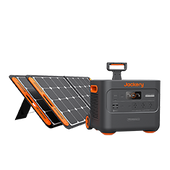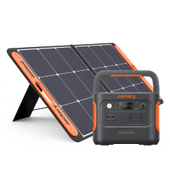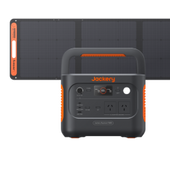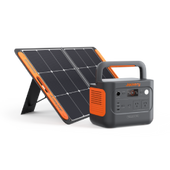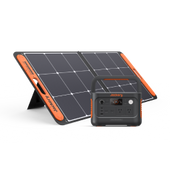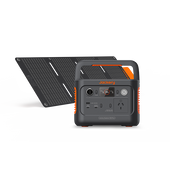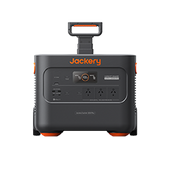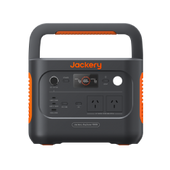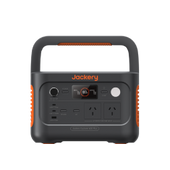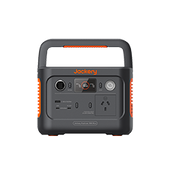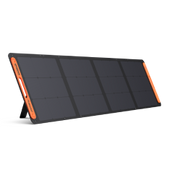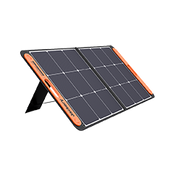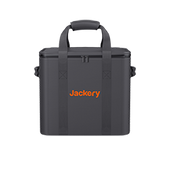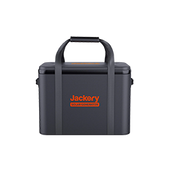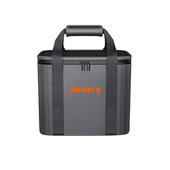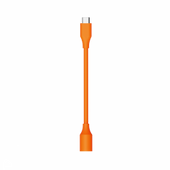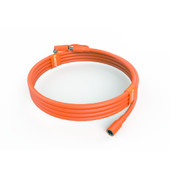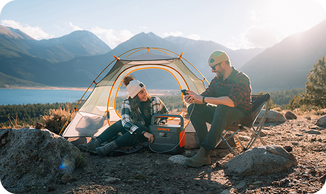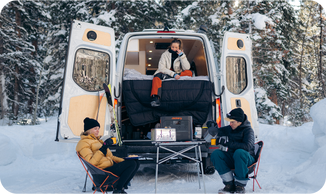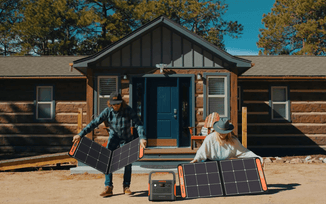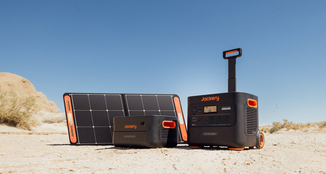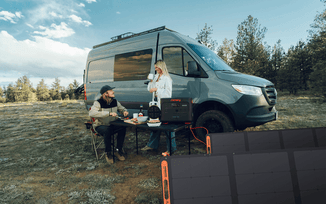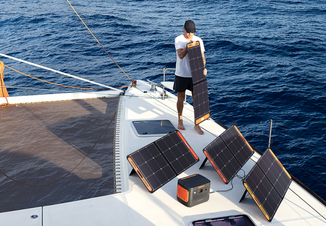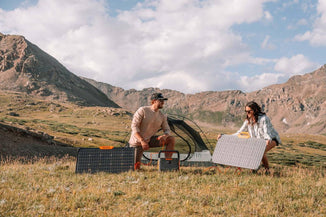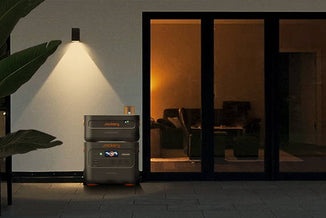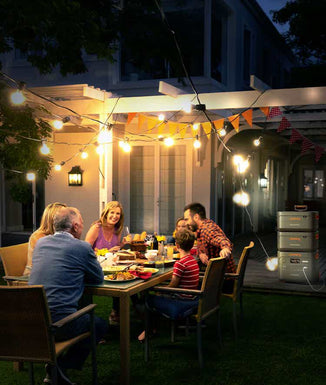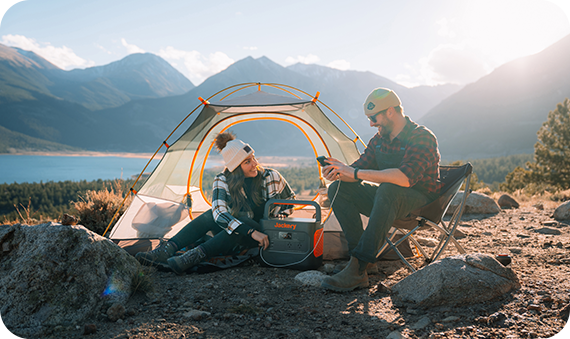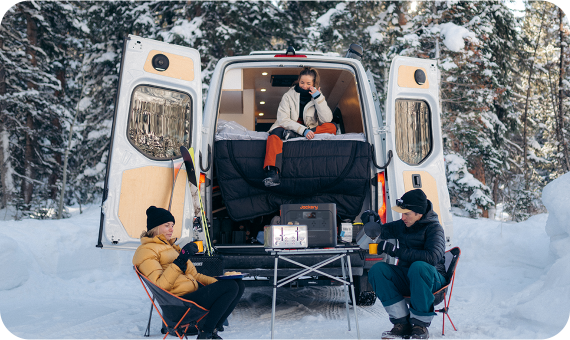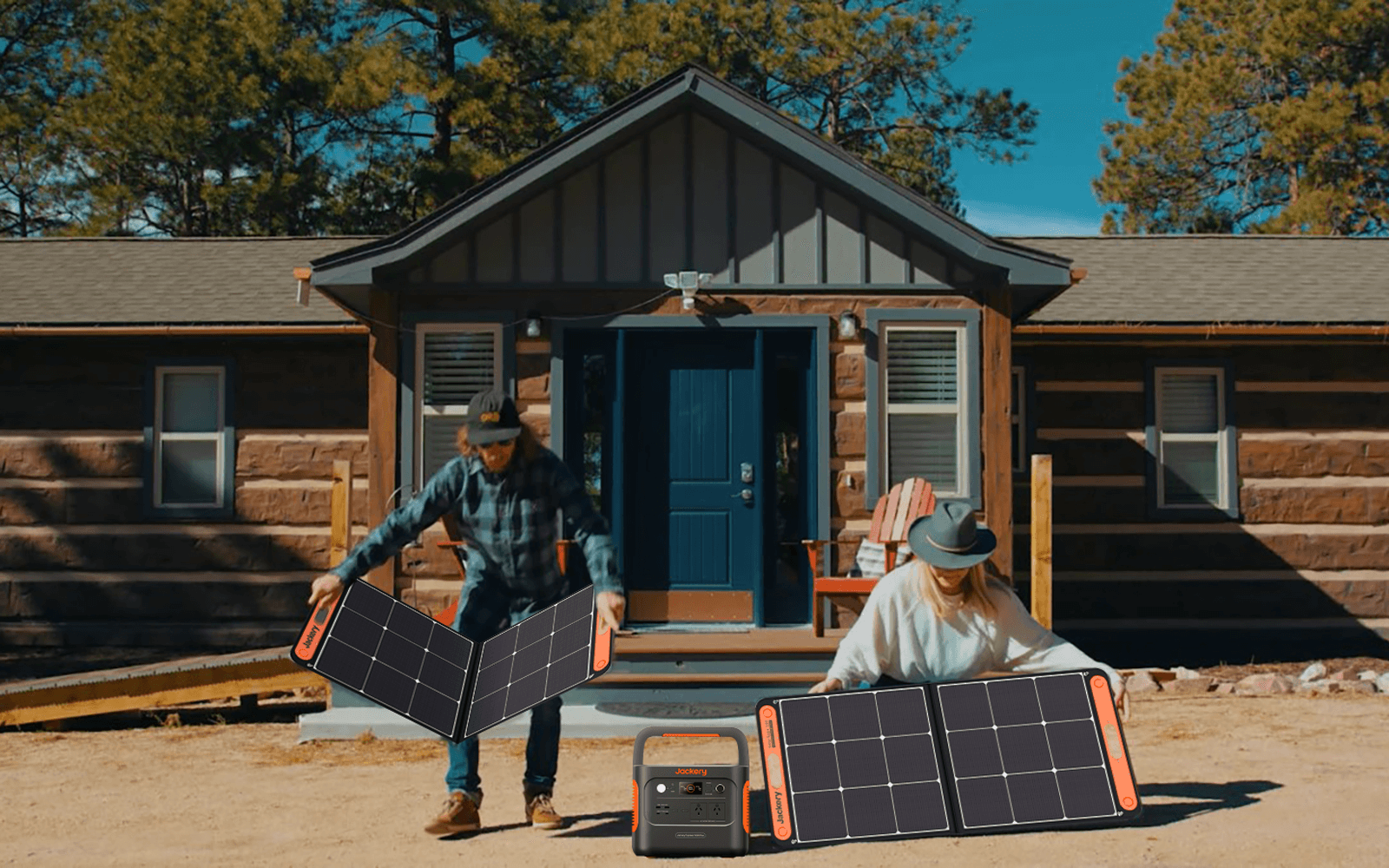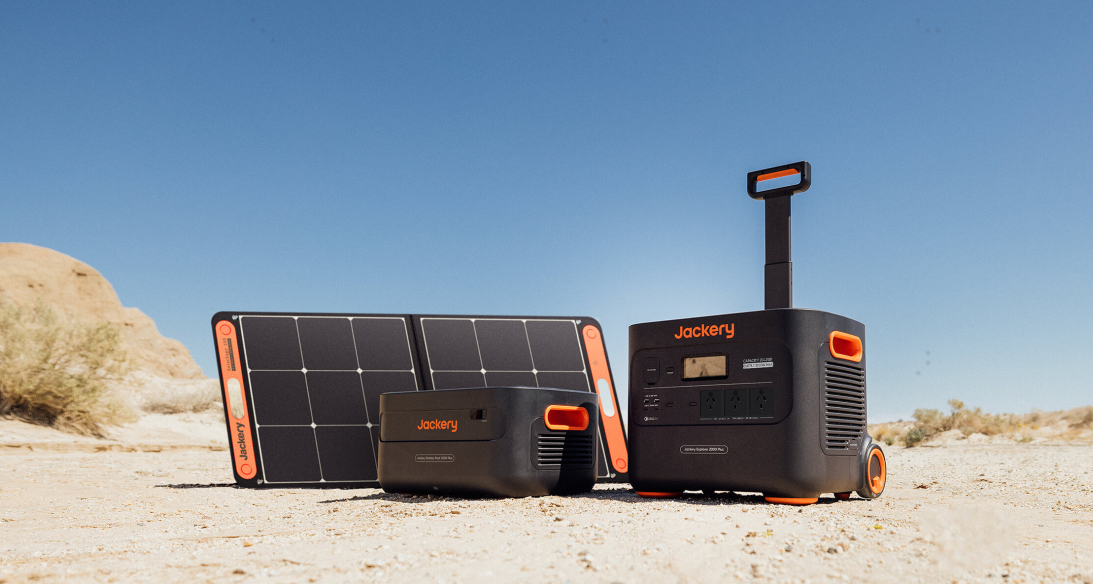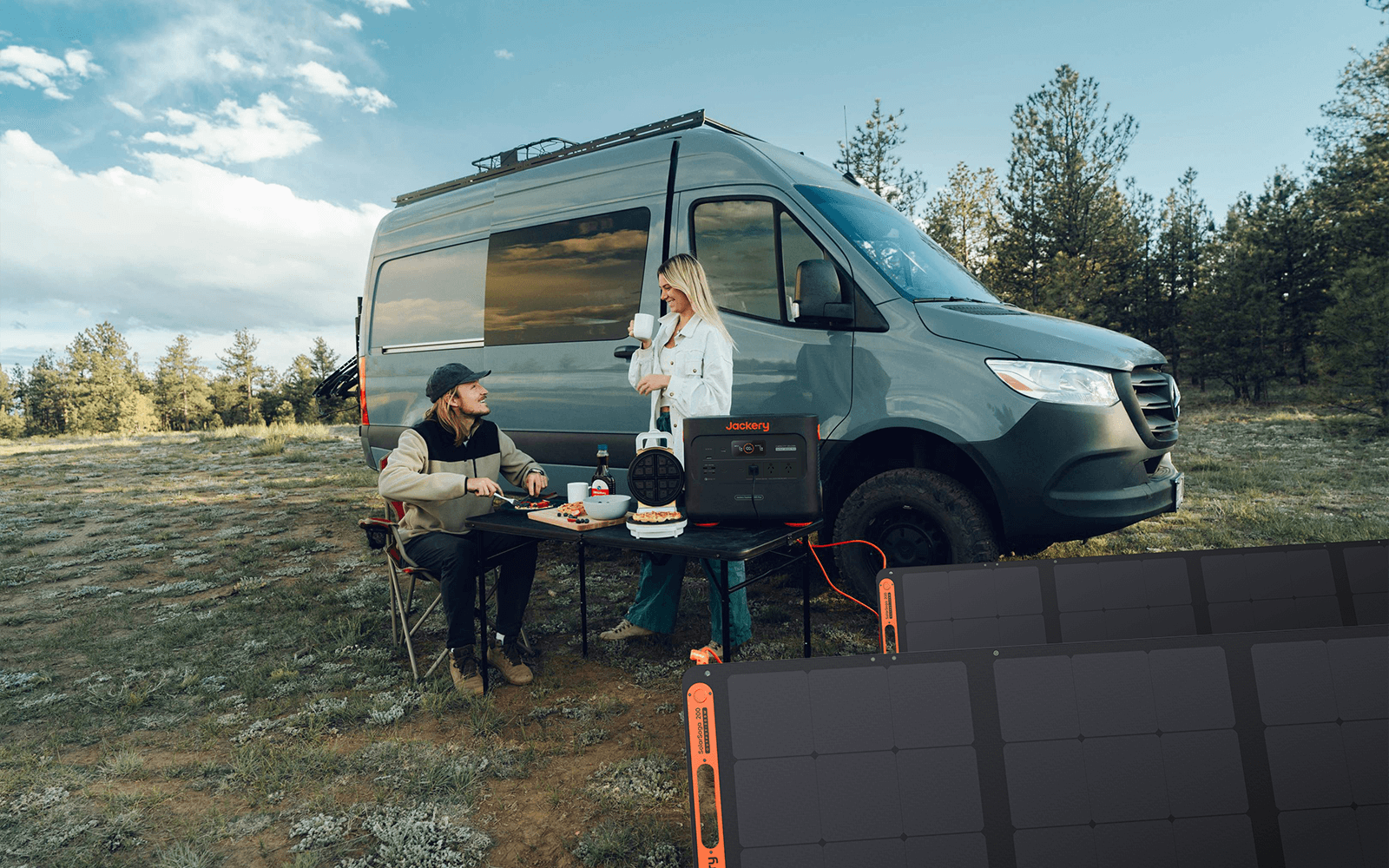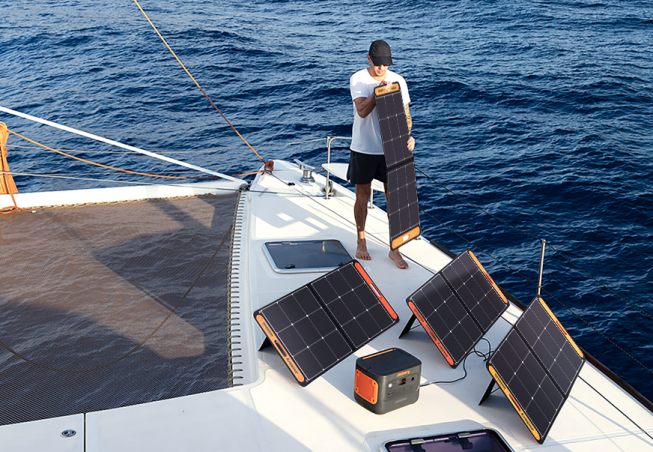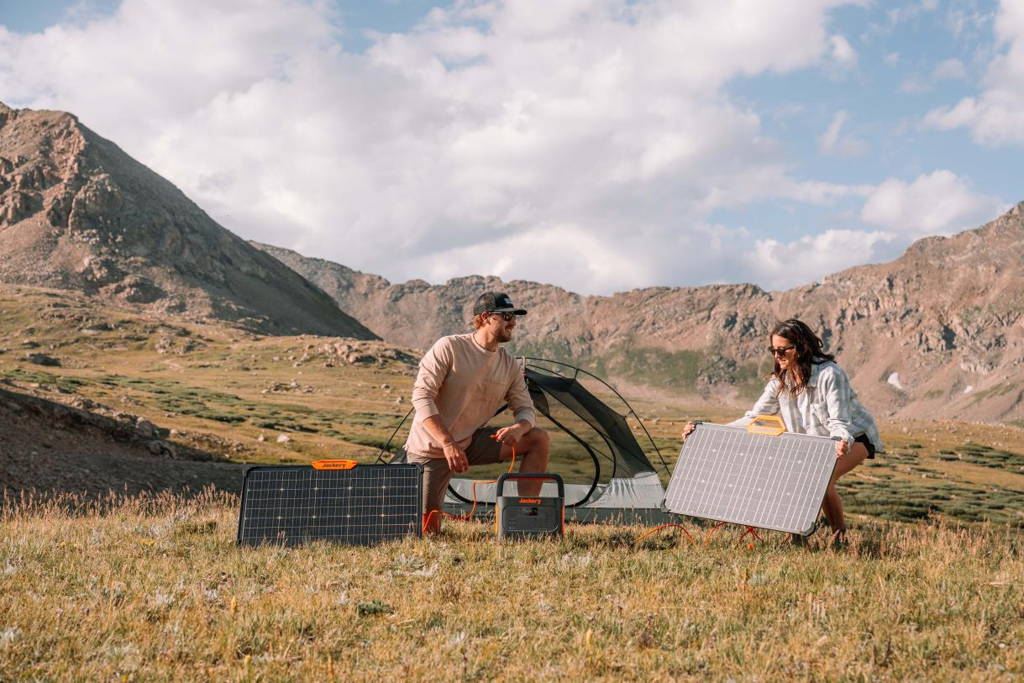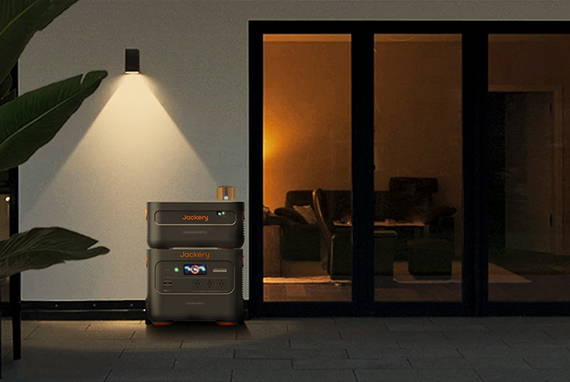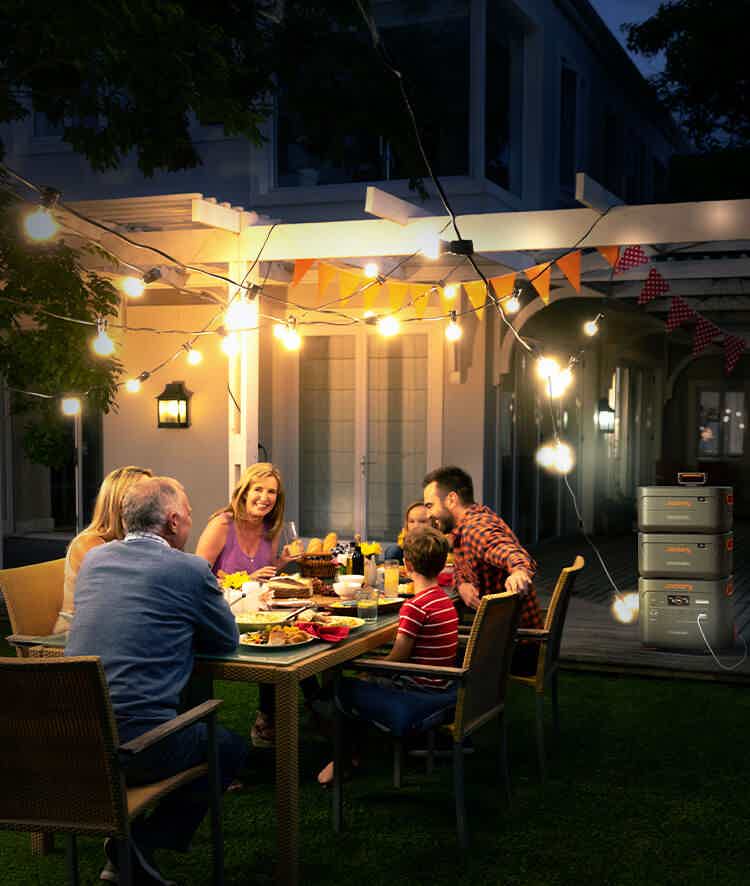|
Key Takeaways: |
|
- Cradle Mountain is known for its snowy season because of its unique wintery scenery. - This guide lists facilities, shuttles and entry, and accommodation at Cradle Mountain to make you prepared well. - Here is an 8-day Cradle mountain expedition walk itinerary that takes 65km in winter. - Winter can be the best time to spot some of Tasmania's most famous and rarest wildlife, and Cradle Mountain's shyest creatures are likelier to venture out. - We recommend Jackery Solar Generator 600 Plus and 300 Plus to charge camping appliances and your personal electronics when visiting Cradle Mountain in winter. |
Cradle Mountain in Winter
Located in the centre of Tasmania's north-west lies Cradle Mountain. Because the west of Tasmania is known for having wetter weather, the consequence is lush, verdant, breathtaking forests. Cradle Mountain is well-known for its snowy winter season. The verdant woods transform into an incredible winter paradise that is unimaginable.
What Is the Weather Like at Cradle Mountain in Winter?
In Cradle Mountain, July, August, and September usually have the highest precipitation, rainfall, wet days, and snowfall during winter, with June closely behind. With an average of almost 18 days of rain or snow and well over 200 mm (8 inches) of precipitation, August is the year's wettest month. Similar amounts of rainfall occur in July and September, although most come from snow rather than rain.
Throughout the winter, Cradle Mountain has average daily highs of around 8°C (46.4°F), with average lows of about 2°C (35.6°F). Although it might also get below freezing at night in other winter months, July is usually the coldest month.
How Beautiful Is the Cradle Mountain in Winter?
Wintertime at Cradle Mountain is quite magnificent. The surroundings change into a tranquil paradise with snow-covered peaks strikingly contrasting with the deep blue sky. The chilly air makes the panorama more vivid, and the snow may give the untamed country an almost mystical appearance.
Tasmania's winter light may be ethereal and gentle, with lengthy shadows created by low, golden rays that accentuate the textures of the ice and snow. If you're ready for the cold, the serene ambience, frequently broken by crunching snow beneath your feet, makes it an ideal time for contemplation or energising walks.
Winter provides an opportunity for wildlife enthusiasts to witness rare animals that have adapted to the local environment. With fewer people using the trails, you may have the entire splendour of Cradle Mountain to yourself. You may immerse yourself in the breathtaking, pristine nature when the typical throng isn't around.
What to Expect for Cradle Mountain in Winter
June to September is Cradle Mountain's winter season. There is a lot of rain, snow, and chilly weather now. It's also an opportunity to witness this enchanted environment at its most enchanting.
You may enjoy the breathtaking scenery of Cradle Mountain in a magnificent, snow-draped light and escape the heavier crowds in other months. Cradle Mountain offers a year-round array of winter activities, walking paths, and wildlife-watching possibilities that draw crowds throughout the warmer months.
The Cradle Mountain area has many different types of rocks because glaciers have worn down and deposited rocks there over the last two million years. Many different glaciers covered the area and left behind many glacial features, such as the valley of the Dove River and many lakes and tarns.

Cradle Mountain comprises many plants, from rainforests to button grass moorlands. The area is home to very old plants that come from Gondwana. It has long-lived Indigenous conifers like the King Billy pine, the pencil pine, and the celery-top pine. It also has Tasmania's deciduous beech (Fagus), which turns the hillsides orange every fall.
Animals that live in the area, like velvet worms, fish in the family Galaxiidae, aquatic insects, and crabs, show that it has a Gondwanan history. Other invertebrates, like the pencil pine moth, show more ancient connections to the supercontinent Pangea.
Facilities
Situated just outside the park's northern boundary, the Cradle Mountain Visitor Centre houses a gift store, cafe, and offices for tour operators. At the lake's southernmost point, on the banks of Cynthia Bay, is the location of the Lake St. Clair Visitor Centre. In addition to having a restaurant, the Lake St. Clair Lodge also takes reservations for the lake ferry.
How to Get There
Private cars are not allowed on the route between 8 am and 6 pm, October through March, and 8 am and 5 pm, April through September, when national park shuttle buses operate between the Cradle Mountain Visitor Centre and Dove Lake. Shuttle bus tickets are included in your parks pass, which is necessary to enter Tasmania's national parks.
Shuttle: The shuttle bus runs seven days a week and starts from the Cradle Mountain Visitor Centre. You will need a current Parks Pass and a shuttle bus ticket, which can be arranged at the Visitor Centre.
The shuttle bus service is part of both the Cradle Mountain Day Icon pass and the fee for booking the Overland Track. From the Visitor Centre, the shuttle bus goes to the Ranger Station or Interpretation Centre, Snake Hill, Ronny Creek, and Dove Lake. From the Visitor Centre to Dove Lake, the trip takes about 20 minutes one way.
Summer and winter shuttle bus times can change. The weather can change the state of the roads, which can change when they can be used. Check with the Visitor Centre before you come.
Private Vehicle: Private vehicles can only get to Dove Lake in certain areas outside of service bus hours and park there. This has nine parking spots for private cars and one parking spot for people with disabilities.
You can't drive a campervan, motorhome, caravan, trailer, or any other similar vehicle on Dove Lake Road at any time. People in these types of cars will have to park at the Visitor Centre and take the shuttle bus to get into the park.
Accommodation
Both Lake St. Clair and Cradle Mountain have campsites. Cradle Mountain, on the park's border, offers lodging options. Choose from a "tiny escape" under the Milky Way, an alpine retreat in a comfortable cottage, a rustic highland cabin made of natural wood, or an upscale hotel.
Indulge in a spa treatment indoors at Cradle Village or outside at the opulent Peppers Cradle Mountain Lodge, which boasts an outdoor spa overlooking the forest and is surrounded by walking paths and animals. The peak is thirty minutes from lodging in Sheffield, an artistic town.
Lodging options are available near the township of Derwent Bridge, at Pumphouse Point, and on the beaches of Lake St. Clair at Lake St. Clair Lodge.
Food and Drink
If the trekking snacks aren't fulfilling enough, head to a nice restaurant for a more fulfilling meal. For takeout or dining in, visit the "highest restaurant in Tasmania," CMWV Resort Restaurant, where you may graze while enjoying wine, whisky, and a view of Cradle Mountain.
Altitude Restaurant offers sumptuous buffet breakfasts and meals that fuel your appetite for adventure. Come warm up by the fire. Alternatively, unwind at Tavern Bar and Bistro with your friends over a game of pool and a Tassie artisan beer.
Check the detailed Cradle Mountain guide to learn more about it.
How to Keep Safe When Visiting Cradle Mountain in Winter
In Cradle Mountain, the weather can change quickly and often, especially in the mountains. It can snow, rain, wind, or shine at any time of the year. From October to March, bushfires can happen.
Your basic walking gear should not be the only thing you bring with you when you go to alpine areas. You should also bring a waterproof jacket with a hood and a storm front made of seam-sealed and breathable fabric, like Gore-Tex or similar material; waterproof over pants also made of seam-sealed and breathable fabric; sturdy walking boots; and warm clothes like a fleece or wool sweater, thermal base layers, a hat, and gloves.
There have been deaths when people were not ready for cold, wet, windy weather. When this happens, kids, older people, and people who are sick or have a disability are most likely to be hurt.
Regardless of the season, a self-drive vacation in Tasmania is a satisfying experience. Winter is a terrific time to explore this unique state because there are fewer tourists at popular tourist destinations and quieter roads.
You may have a pleasant and trouble-free driving trip with some preparation and local knowledge. Most of the time, you can take detours to avoid slick roadways. Here are some tips to ensure your safety if you drive in Cradle Mountain in winter.

Step 1: Plan Ahead
Consult a road map before making travel plans, and choose a route that uses all-weather routes. For example, there are several access routes to Cradle Mountain. Access roads from the east are the finest to use in the winter as they are often ploughed and seldom close for extended periods. Gravel roads are generally best avoided in July, August, and September.
Before leaving for your following location, always check the Bureau of Meteorology website and ask the hotel personnel for guidance on local conditions. Statewide road closures and possible dangers are announced via Tasmania Police Community Alerts. If driving during the day is your preference, remember that darkness falls very early.
Step 2: Hire Vehicle
To ensure the automobile is dependable and has snow equipment, rent a car from a respectable organisation. When in doubt, ensure the tyres, wipers, and batteries are in excellent shape. If you have never used snow chains, ask about their necessity and fitting instructions (though chains are rarely required). Enquire if there are any special driving instructions for the exact car you have booked on icy, rainy, or snowy roads. Don't forget to give the car enough time to melt any morning frost before you go for a trip.
Step 3: Safe Winter Driving
The critical thing to remember in low visibility or ice circumstances is to proceed with caution and common sense, just like you would in any dangerous circumstance. Recall the following fundamental traffic laws:
- Put on your headlights and slow down significantly
- Remain far behind the leading vehicle
- Notice cautionary indicators
- Maintain a defrosted windscreen
- If water is present on the road, stop
- Watch out for black ice
What to Do at Cradle Mountain in Winter?
There are many things you can do in Cradle Mountain during the winter season:

Hiking
Many disregard it as a less appealing time to hike, but beauty is unveiled for those willing to layer up. This eight-day adventure frequently produces a wintry wonderland for snow enthusiasts. This is a schedule for an 8-day, 65-kilometer Cradle Mountain Expedition Walk.
|
Day 1 |
Launceston to Cradle Valley
|
The first day is spent travelling slowly to Cradle Valley. With enough time to eat supper at Cradle Mountain Hotels before turning in for the night, you may arrive at the Cradle Mountain Hotel between 4 and 4.30 pm. |
|
Day 2 |
Cradle Valley to Barn Bluff Hut |
If the weather permits, take a lunch break by the serene Plateau Creek and then walk for about four hours around the foot of Cradle Mountain along the edge of a breathtaking glacial cirque. |
|
Day 3 |
Barn Bluff Hut to Pine Forest Moor Hut
|
About six hours on foot (longer in inclement weather) You may stroll across plains formerly covered by glaciers slowly receding and eroding shallow tarns. This is an undulating journey with some exposed moorland stretches, but it has no substantial hills today. |
|
Day 4 |
Pine Forest Moor Hut to Pelion Hut |
Walking time: around 5 hours (longer in bad weather). You'll start with a stroll along the foot of Mount Pelion West, descending slowly to the Forth River, which flows into the Lemonthyme Valley. There are many side trips in the Pelion Plains area, with mountains all around, abandoned copper mines, and serene, humble places to sit quietly if the weather permits. |
|
Day 5 |
Pelion Hut - contingency day |
Not required Mt Oakleigh or Mt Ossa. There are several possibilities for today, primarily relying on the cold weather. You are quite welcome to unwind and enjoy a nice rest day at Pelion Hut. If the weather is nice, you may climb Mount Oakleigh (1252m) or Mount Ossa (1617m). |
|
Day 6
|
Pelion Hut to Kia Ora Hut |
About four hours on foot (longer in inclement weather) The first part of today is an almost 300-meter ascent through a stunning jungle to reach the Pelion Gap. The plateau, Pelion Gap, between Mount Pelion East and Mount Ossa, offers breathtaking north and south views. |
|
Day 7 |
Kia Ora Hut to Windy Ridge Hut
|
About five hours on foot (longer in inclement weather) From then on, you may stroll through some of the national park's oldest woodland, where King Billy pines can be up to 2000 years old. |
|
Day 8 |
Windy Ridge Hut to Lake St Clair |
About three hours on foot (longer in inclement weather) Today's destination is Lake St. Clair, Australia's deepest naturally occurring lake, sculpted over two million years by glaciers. Descending the hard Western Tiers, the return route to the walk base at Red Feather Inn passes via the highland lakes, a trout fishing haven. |
Soaking Up the Scenery While Soaking in a Tub
The already breathtaking scenery in the area is enhanced by the majesty of the snow that winter delivers to Cradle Mountain. There's plenty of winter scenery, from the snow-capped peaks of Cradle Mountain and Mt. Ossa to the boardwalks and fields of Cradle Mountain's pathways.
Don't forget to look out for tunnelling wombats making their way through the snow. Several Cradle Mountain hotels and lodging establishments provide hot tubs or luxurious spas, among the most incredible places to enjoy the chilly landscape.
Cuddle Up with Tasmanian Wildlife
Many local animals find refuge in Cradle Mountain; don't worry, they're used to the harsher, wetter winter weather. Since fewer people are around, some of Cradle Mountain's more timid animals are likelier to step outside, making winter the perfect time to see some of Tasmania's most well-known and uncommon wildlife.
The platypus is the most elusive of all; it is seldom sighted close to riverbanks and rivers, especially around Lake St. Clair in the southernmost parts of the national park. You often spot snow-dusted wombats burrowing and wobbling near the Cradle Mountain visitor centre and hamlet.
You can also sometimes spot inquisitive echidnas searching for worms, as evidenced by their thick coats and prominent spikes, which show they don't let bad weather stop them. The fantastic Devils at Cradle conservation facility, accessible year-round, is ideal for getting up close and personal with the well-known Tasmanian devil.
Wombat Spotting
For Australians, it is mind-boggling to see a wombat coated in snow. Said, we're not used to seeing our marsupials in the winter. However, watching these plump tiny wombies amble over button grass covered in a few inches of snow is the prettiest thing ever.
The Wombats at Cradle have the advantage of assembling in a few significant low-lying locations. Thus, going wombat spotting in Cradle in the winter is legitimate and enjoyable. Knowing the park well allows you to get quite comfortable with where to look for them. Now, put on your snow gear and head for the trails. The wombats will be waiting for you here:
Opposite Peppers Cradle Mountain Lodge: Stroll down the park's main road from the lodge and ascend the hill toward the visitor's centre. A floating walkway may reach Pencil Pine Falls. Wombats are usually seen here feeding. If you look, they look like the grass.
Ronny Creek: Our reliable site for wombat sightings. Stroll along the boardwalk across the moorlands and take in the view. You're sure to spot a few wombats.
Enchanted Walk: For Wombats, this is a hit-or-miss type of place. Right next to the route are two or three caves, and if you're lucky, you could spot a wombat or two coming or departing.
Jackery Solar Generators for Winter Outings
Snow-covered trails and breathtaking alpine landscapes feature in Cradle Mountain's transformation into a winter wonderland. A solar generator, like Jackery Solar Generator, is essential for winter camping because it provides a steady, renewable source of electricity to charge necessary devices like headlamps, phones, and GPS units without relying on fuel or noisy generators.

This is especially important in remote areas where access to power outlets is limited, especially in the winter when battery life can drain quickly due to shorter daylight hours. Solar panels can still produce power even on cloudy days, making them very useful when cold outside.
They are built to last through any journey and can safely work from 14°F to 113°F. Their steady power gives you peace of mind no matter where you are. Even if you use them every day, Jackery's Plus series can last up to 4000+ hours, which is a long time.
Jackery Solar Generator 600 Plus
With Jackery's dependable energy options, you can power your cameras, GPS units, or even little heaters, guaranteeing a pleasant and connected journey through the untamed splendour of Cradle Mountain. Allow Jackery to add portable, sustainable power to your winter expedition.
The Jackery Solar Generator 600 Plus combines innovative technology with unmatched versatility. Its dual USB-C ports, including a 100W fast-charging option, and dual AC outlets (800W rated, 1600W peak) ensure compatibility with modern gadgets and essential appliances. This generator easily meets all your power needs, from charging smartphones to running small fridges.
The advanced Battery Management System (BMS) provides multiple layers of protection against overvoltage, short circuits, and high temperatures. With its pure sine wave inverter, the Solar Generator 600 Plus can deliver stable, safe power to sensitive devices like laptops and cameras.
Paired with the efficient SolarSaga 100W solar panel, this generator offers renewable energy for off-grid adventures. Designed for flexibility and reliability, the Solar Generator 600 Plus is the ultimate power solution for outdoor enthusiasts and emergency preparations.

|
Jackery Solar Generator 600 Plus Working Hours |
|
|
Camping Lights (30W) |
16.9H |
|
Electric Blanket (200W) |
2.5H |
|
Electric Hand Warmer (60W) |
8.4H |
|
Portable Speaker (100W) |
5.1H |
|
Camera (150W) |
3.4H |
Jackery Solar Generator 300 Plus
The Jackery Solar Generator 300 Plus is the ultimate portable power solution for outdoor enthusiasts and on-the-go adventurers. Weighing just 4.95kg (including the Explorer 300 Plus and 40W solar panel combo), it combines unmatched portability with a robust 288Wh capacity and 300W output. Whether camping, hiking, or enjoying a day outdoors, this compact powerhouse fits perfectly into your backpack, offering infinite power wherever your adventures take you.
Equipped with dual PD ports delivering up to 100W for fast charging, it supports multiple devices simultaneously with various charging options. The durable Lithium Iron Phosphate (LiFePO4) battery ensures a long 10-year lifespan, while ChargeShield technology and a pure sine wave output guarantee stable and safe performance for all your devices.
With solar charging capabilities that achieve a full charge in just 9.5 hours using a 40W panel, the Jackery 300 Plus is designed for efficiency and reliability. Stay connected and powered with the cutest and most portable solar generator on the market, whether at home, on the road, or exploring the great outdoors.

|
Jackery Solar Generator 300 Plus Working Hours |
|
|
Camping Lights (30W) |
8H |
|
Electric Blanket (200W) |
1.2H |
|
Electric Hand Warmer (60W) |
4H |
|
Portable Speaker (100W) |
2.4H |
|
Camera (150W) |
1.6H |
Cradle Mountain in Winter FAQs
The following are the frequently asked questions about Cradle Mountain in winter.
1. Is it safe to drive in Tasmania in winter?
Driving becomes particularly riskier in Tasmania during the winter months due to the possibility of extreme weather conditions such as frost, black ice, and snow. Listen as the Tasmanian Automotive Chamber of Commerce (TAC) walks you through pre-winter vehicle checks and safe driving guidelines.
2. Is Tasmania as cold as New Zealand?
Although warmer and sunny than the South Island, Tasmania has a comparable climate. Tasmania's milder winters cause the higher yearly average temperatures.
3. What is the coldest city in Australia?
Liawenee. But those complaining and suffering in the icy mornings ought to consider the two residents of Liawenee, Australia's coldest inhabited location.
4. What month is best to visit Cradle Mountain?
Although there isn't one optimal time to visit Cradle Mountain–Lake St. Clair National Park, certain months could suit your desired activities. Visit in December or February for hiking, swimming, and milder weather, or in June or August for snowy scenery and comfortable fireside evenings.
Final Thoughts
Cradle Mountain is even more spectacular when there is snow. As we reveal the best ways to visit Cradle Mountain during the winter with our comprehensive guide, you'll understand what we mean. Find secret paths, warm havens, and magnificent views of the wintry landscape. You'll need a National Parks Pass to visit Cradle Mountain. In Tasmania, a permit is required to enter any National Park. When you go to the Visitor Centre, you can purchase your pass if your only plan is to see Cradle Mountain.

